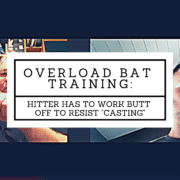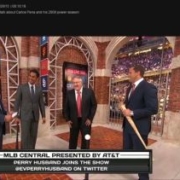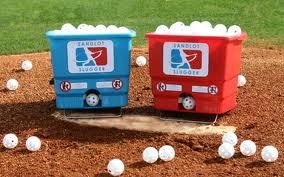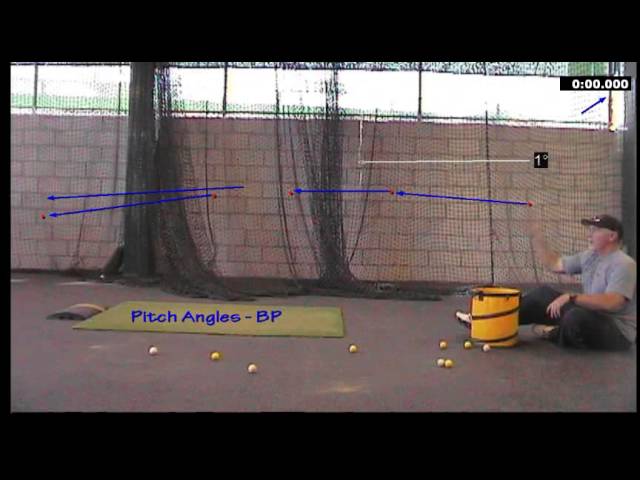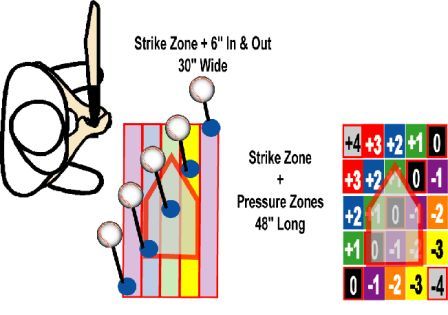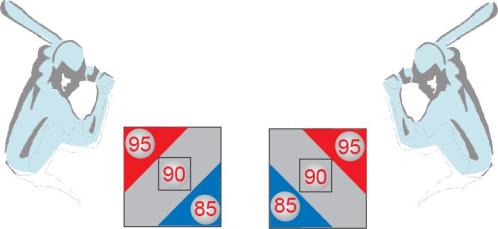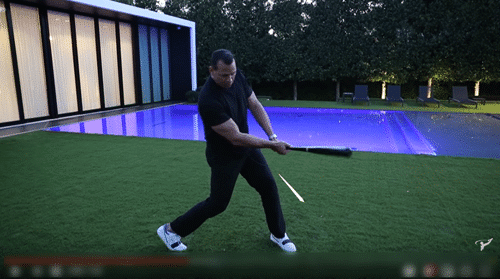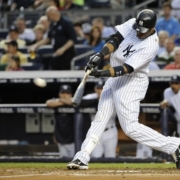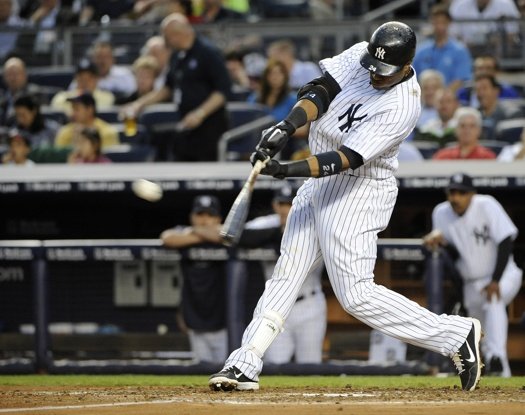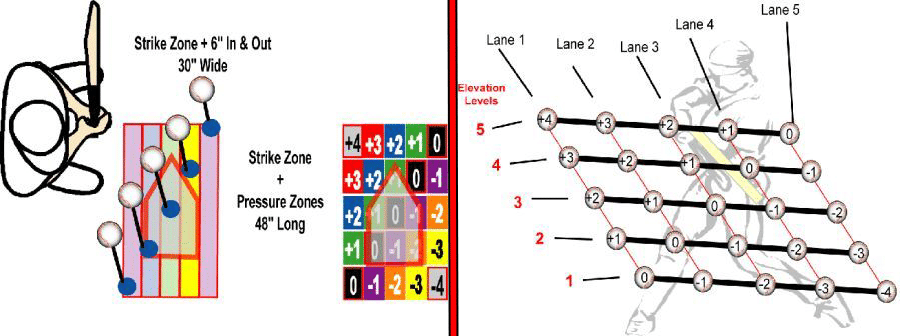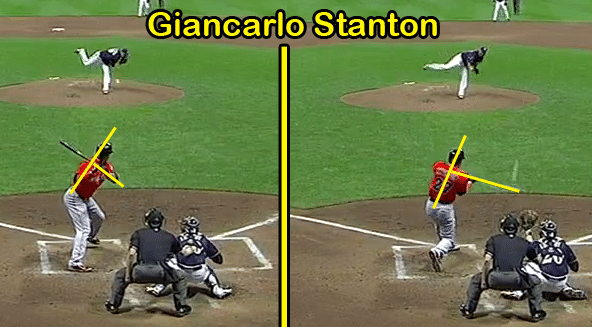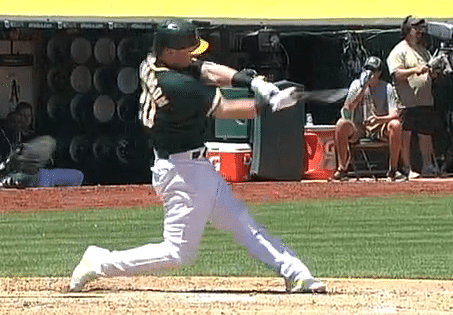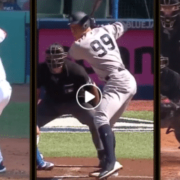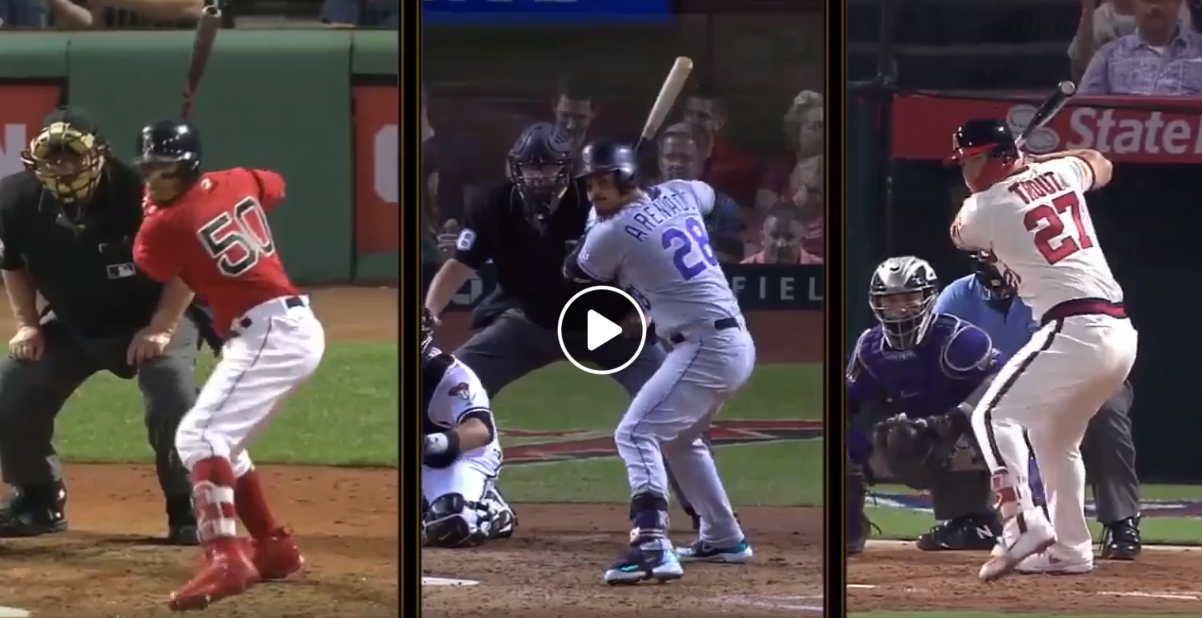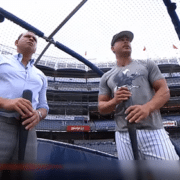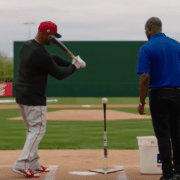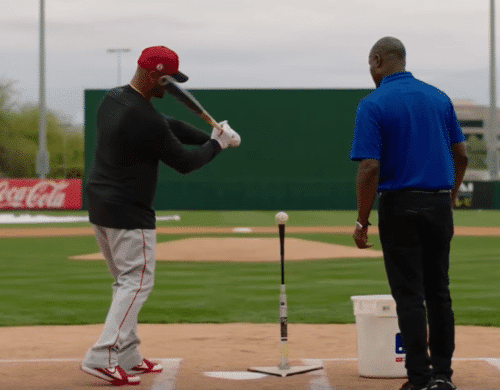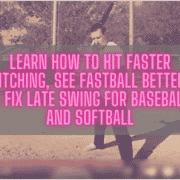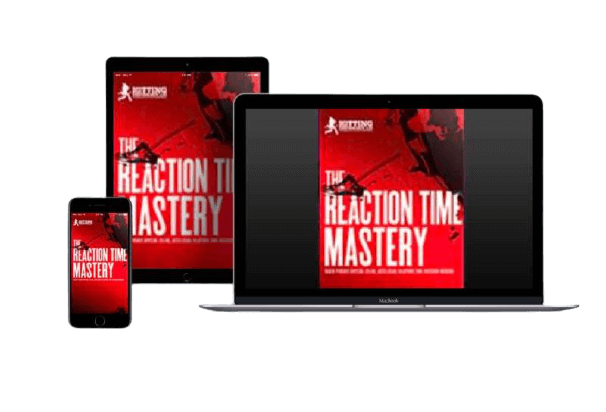Discover Perry Husband baseball and softball drills – the Effective Velocity hitting formula. Learn how to train and get the front foot down early on and on-time, improve and work on timing, and fix a late swing.
Effective Velocity: Perry Husband Talks About How To Get 100% On-Time & 100% Swing Efficient

Perry Husband being featured on MLBNetwork with Carlos Pena explaining Effective Velocity. Photo courtesy: MLB.com
I’ve just put together a NEW online video course called Reaction Time Mastery, where we dig into the FOUR following topics:
- Forward Momentum (FoMo),
- Vision,
- Tracking, and
- Timing…
The Reaction Time Mastery online video course will help hitters track pitches crystal clear, accelerate decision-making reaction time, & get ON-TIME without losing swing effectiveness.
Because some of the above topics are slightly above my pay grade, I enlisted the help of specific proven experts…a couple Doctors, and a few “Mad Scientists” about their respective topics. I asked these experts to contribute a 10-minute video or two to the Reaction Time Mastery online video course, and if they were up for it, an interview for the blog.
And here we are, expert interview #1! For those who don’t know Perry Husband, he was featured on the MLB Network about the work he did with Carlos Pena using his Effective Velocity and Exit Velocity programs (EV).
CLICK HERE for an SBNation.com post about Perry Husband and his Effective Velocity system titled, “The Essence of Velocity: The pitching theory that could revolutionize baseball, if only the sport would embrace it”.
I believe Perry Husband has a truly revolutionary approach for hitters (baseball and softball). And I wanted to share the following interview, where he answered a few pointed questions from my readers.
Just to warn you though, this post is a BEAST, and for some, may take up to 30-minutes to get through. But let me encourage you…the information Perry distills about Effective Velocity, is golden.
So kick up your feet, grab a brew of choice, and get to work.
Perry’s website can be found at EffectiveVelocity.com, and I’ll link to where you can find him on social media at the end of this post.
Enter Perry Husband, and his Effective Velocity system…
SCIENCE-BASED TRAINING:
Improve your hitting strategy dramatically by applying human movement principles.
Learn not only how and what to train but also the science behind the methods.
“What are some great drills to practice vision/tracking?”
There are many drills that I would recommend to practice vision and tracking, but first I would say it is important to understand ‘how’ to see before you try to get better at ‘what’ to see.
Many of the vision drills that I have been introduced to, involve trying to get the eyes to focus on small details of a pitch, such as a tennis ball with a color or a number that the hitter is to identify.
I have been guilty of teaching players to focus in on small objects such as small beads with numbers and letters on them and many other detail oriented drill work. Ask the hitter to identify and only swing at certain letters etc…..
However, what I found is that this did not lead to the student learning to identify actual pitches any better. I am certainly not an expert in vision training, but I will try to explain my findings like this…
Imagine a ball coming out of the pitcher’s hand and the hitter using the eyes like a camera. The center of the eye picks up infinite detail and the picture of the ball out of the hand is incredibly sharp and in focus. The hitter sees the seams, the signature of the commissioner and yet……all that intense detail does absolutely nothing to help us know what pitch it is nor where or how fast it will arrive.
The still photo does not tell us the direction, spin, speed, pitch type or even whether it is a ball or a strike.
Now imagine the ball being recorded with an old video camera that is very unclear but shows an out of focus video of a pitch traveling 10-feet. Which image would you rather have to hit the pitch, a clear photo OR a fuzzy video?
The eye has the ability to work as a camera and a video camera, but which way do you think the small detail training is heading towards?
Upon this discovery about 1990, I began teaching using a very different technique to help hitters learn to use their eyes like video cameras instead of still photography cameras. Hitting a 95 MPH fastball is not about detail, but rather about:
- ‘Where’ (initial direction or tunnel) it is going?
- ‘How fast’ (radar speed) is it moving?
- ‘Where’ will it move toward (pitch movement)?
- ‘Where’ will it end up (location in the zone)? And,
- ‘When’ (Effective Velocity – or EV).
Now, of course there is spin to help hitters identify pitch types etc…. but the primary information hitters need is basic and quick and not all hitters can see spin well enough or soon enough to have it help them.
I began taking out the small details and began focusing on the bigger ticket items. Once we narrow the focus or rather broaden the focus to see the pitch in a different way, now we can practice the important factors.

Effective Velocity: Vertical Plane LHP. Photo courtesy: HittingIsAGuess.com
I introduced a term called ‘Shape’ in my work with Carlos Pena in 2009. Every pitch has a shape after it travels about 30-feet or so. You can picture:
- A curveball with the big loop,
- A slider with a smaller hump or loop,
- A sinker shape, or
- A straight Kershaw four seamer.
Every pitch has a starting tunnel, movement laterally, or down and a final location. The path the ball takes out of the hand to about 2/3 of the way to the plate is what creates ‘Shape’.
We can’t wait until it is completed all the movement before we have to swing because it takes about 1/3 the flight or about 18-20 feet to swing the bat.
Hitters have a 1/3 of the way to see direction and the beginning of spin and another 1/3 to see spin (pitch type/speed), estimate the final location and then begin the swing.
I named my initial hitting program Hitting Is A Guess, partially for this very reason……….it is most certainly a guess on many different levels and vision is just one of those levels. I began training hitters to make better guesses………..and this worked very well.
Using smaller objects is one way to begin training the eyes to start ‘drinking’ in the pitch info in the right way. Like speed reading, hitters begin clumping sections of the pitch like a whole sentence at once, which helps you see the pitch in shapes.
The shape is key to knowing speed and final location in the shortest amount of time.
My favorite drill set is…

Effective Velocity: Golf sized foam balls
To use small golf ball sized foam balls to train hitters to identify pitch traits sooner and more efficiently, which is part of my Time Training Level 2 hitting program.
to train hitters to identify pitch traits sooner and more efficiently, which is part of my Time Training Level 2 hitting program.
This is done from a seated position to get the pitch trajectory as close to games as possible and at a distance of 16-20 feet from the hitter. The balls are different densities so the same arm action can create multiple pitch speeds.
Pitch traits help hitters identify pitches, which in turn helps them time pitches better. Reproducing these traits with a baseball is not easily done. The small foam training balls are much easier to create game-like movements, trajectories, EV speeds and shapes. They require some practice throws to get a feel for controlling them, but this is the very best way to get the closest to real live pitch traits without being in a game situation.
In my opinion, there is no comparison of these foam balls to wiffle balls. The wiffle balls do not fly the same, are harder to create movements, they hurt when you get hit with a ball off the bat at close distances and they break much faster. I have used these [foam golf balls] for almost 10 years, and have destroyed less than 1% of them over all that time.
The Circle Drill Set is…
Another part of my Time Training Level 2 hitting program that helps read the first 10 – 15 – 20 – 30 feet of flight. There are speed awareness drills, early pitch recognition drills and all of them designed to maintain the most efficient swing possible at the same time.
The Time Training program was designed to introduce hitters to the most logical skill sets in the order that makes the most sense, based on my crazy amount of testing hitters, as well as the 3 decades of teaching hitting on all levels.
Grab This FREE 'Timing Master Class' Video
Struggling to get your hitters ON-TIME in games? Discover HOW TO build effective laser-focused timing, so your hitters can be ON-TIME more often. These principles are validated by REAL science.
Click the button below to access the FREE video that has been downloaded over 6K times!
Click here to 'Get Instant Access'
“How do you get your hitters enough practice at high pitch speeds? Example … Is throwing 45 from 30 feet the same as throwing 90 from 60 feet?”

Effective Velocity: pitch angles. Photo courtesy: HittingIsAGuess.com
The previously described small ball training at 15-20 feet (golf ball sized foam balls ), 7 inch baseballs at 30-36 feet and simulated BP from the closest to game mound as possible. Most of the work becomes about game simulations and creating the perfect speed to match a pitcher type.
), 7 inch baseballs at 30-36 feet and simulated BP from the closest to game mound as possible. Most of the work becomes about game simulations and creating the perfect speed to match a pitcher type.
Simulating game speeds is easy enough, but that it is just the beginning of true simulation and training hitters to ‘hit’. We learn to ‘swing’ and then we learn to ‘hit’. Most physical swing designs include both swinging and hitting and this is a mistake, IMHO.
Separating the two things is the only way to truly get the most out of the swing and your approach, otherwise you will always be compromising one or the other.
The real work is in learning to control swing speed, mindset, anxiety control, pitch selection, taking pitches and staying focused on what we really want through a series of pitches we don’t want, dealing with failure and all kinds of other issues.
Hitting is complex, swing design is not.
If you really test all aspects, especially reactionary abilities of hitters, you will come to the same conclusions that I have, which is that learning to swing is very different than learning to hit. Combining swinging and hitting is really the hardest element. Effective Velocity efficient pitchers will eventually force hitters to ‘Act’ rather than ‘React’.
Short distance BP does have some drawbacks, especially if you use baseballs at all distances. A baseball at 60 feet, looks about the same as a 7 inch baseball at 36 feet and a golf ball sized object at 18-20 feet.
I try to stick with these sized objects at these distances to keep the amount of visual info available to the hitter as close to game situations as possible. It will never substitute completely the live at bats from 60-feet but it simply is not possible to get that type of training all the time for most amateur hitters.
To simulate 100 MPH fastball from 18 feet, the BP pitch needs to be 32.7 MPH………this gives the hitter the same amount of time from release to contact.
- 90 MPH is 29.5 MPH,
- 85 is 27.8, and
- 80 is 26.2 etc……..
To simulate from 35 feet, 100 MPH would equal a 63.5 MPH BP pitch………
- 95 MPH equals 60.5,
- 90 MPH equals 57.3,
- 85 MPH = 54.1, and
- 80 = 50.9 etc…
You can never replicate all the factors but the time the ball is in the air is the most important element and that is not too difficult.
I recommend also trying to really pay attention to the pitch trajectory. Standing up at closer distances will create a steeper angle than real game pitches. Seated overhand BP best mimics the same line as a game speed fastball, at least at the higher levels. High school and beyond, I would recommend throwing from a seated position.
“What are some drills or ways to help kids 8-10yo with their timing? I have kids that look great at 20 ft front toss but not so good from 46ft?”

Effective Velocity photo courtesy: HittingIsAGuess.com
I love the small balls for youth players but I treat all hitters pretty much the same until we get into Level 3, game planning.
I fully explain every concept to youth hitters because they are much smarter than we give them credit for. The more they understand why one movement is better than another, the more deeply they will try to make it happen.
I honestly treat the younger hitters the same when it comes to the Level 1 & Level 2 Time Training. It is shocking how good very young hitters are at ‘Acting’ rather than ‘Reacting’ to pitches, once introduced to it. They simply have not had all the years of bad swing training to get in their way of the more natural method of hunting pitches.
Fear and poor thinking (resulting in poor feelings, resulting in poor swings) are the primary reasons that hitters perform well at close distances and not at game distances.
This is another reason that I like the small ball training. Hitters have no fear of being hit. This is another major reason why I named my first hitting program ‘Hitting Is A Guess’.
When you get young hitters to think of it as a guess, they simply make a better guess. After getting comfortable making an efficient guess (swing) for a period, you try to blend that really comfortable swing into drills closer to real at bats.
You have to practice their ‘Game Swing’ if you want that to get better. It is easier to get better at their ‘Practice Swing’, but the game swing is a different animal. Recreate as closely as possible the real speed, distance, visuals, perceived pressures etc…… until they are in control of their game swing as easily as they are for their practice swing.
I put together an instructional league years ago, including a 9 and under team. And when I say they were beginners, I mean we had to use softy balls to play catch day one, for fear of them hurting each other.
By focusing on making good swings in games, not batting average or results, they made major progress very quickly. When you take away the pressure of results, hitters get better at transferring their ‘practice swings’ to their ‘game swings’. You have to practice your game swing if you want it to get better.
Grab This FREE 'Timing Master Class' Video
Struggling to get your hitters ON-TIME in games? Discover HOW TO build effective laser-focused timing, so your hitters can be ON-TIME more often. These principles are validated by REAL science.
Click the button below to access the FREE video that has been downloaded over 6K times!
Click here to 'Get Instant Access'
What is your opinion of FOMO’s impact on being able to hit the curveball?

Effective Velocity: overhead view of lateral lanes. Photo courtesy: HittingIsAGuess.com
I assume that means “Fear Of Missing Out”, not sure on that, maybe forward momentum???
If fear of missing out, this is a major part of why Effective Velocity works and always will, to some degree at least.
Hitters want to cover all pitches, CB, SL, CH, FB, KN and all the rest, and they only have a small 6-MPH Effective Velocity speed range that they will be close to 100/100 (100% on time, 100% swing efficiency).
I believe this has caused most of the poor swing efficiency designs that have caused the severe dip in offense at the MLB level.
My 20+ years of testing proved that hitters have about 5 to 6-MPH Effective Velocity of reactionary ability while being close to 90-100% efficient. When you test using exit velocity, hitters lose roughly 10% of their maximum exit speed with every pitch speed you show them because they are trying to cover all speeds.
If you test hitters with pitches right down central and get a top speed and an average speed, over 10 swings, most hitters will average about 85% or 90% of their top speed. Now put them in a 2 strike mentality (they have to swing at all strikes) and locate the same speed pitch as the first round inside and outside randomly and they will lose about 10% of their average speed over 10 balls.
Now go up in and down away with the same speed pitches and the exit speed goes down another 10%. Add in the off speed pitch that is in the same tunnel as the fastball and the top out tends to drop a bit and the average drops another level.
Most hitters get to 70% all the way down to 40% of their max over a 10 ball average. This is all caused by FOMO…..or trying to cover all speed pitches. It simply cannot be done at or near 100% on time with the 100% most efficient swing.
My goal is to get hitters to be 100/100 or 100% on time with 100% swing efficiency or make their ‘A’ swing exactly on time. FOMO gets hitters closer to 70/70 or 85/85 but rarely, if ever, at or near 100/100.
If FOMO is forward momentum, this is a very different answer and not easily explained. I have to admit that I am not a fan of the term FoMo all by itself. I much prefer to look at the overall swing as either efficient or not.

Effective Velocity zones. Photo courtesy: HittingIsAGuess.com
FoMo is just one element and does not take into account some of the key elements of exit velocity. While increasing FoMo will add to the exit velocity in most cases, that is inherent in a great swing design. The swing is either 100/100 (100% on time/100% efficient……all elements) or some level below that……….and all swing factors are typically affected by a timing change such as CB.
My philosophy requires you to change your paradigm away from sitting in the middle and reacting to all speed pitches, which starts with making the swing efficient as a whole and graduating from ‘Swing School’ to move into timing, pitch recognition and ‘Hunting’.
Effective Velocity works to control Exit Velocity (the other EV) due to the idea that hitters think they can cover all speeds with one approach.
In my teaching, the swing is the same regardless of the speed or type of pitch (at least that’s what we are trying to maintain), so the FoMo will be identical for either swing. If hitters are sitting on a CB, they might load later or create a longer ‘Hang Time’ during the load, this will lead to the same FoMo exactly.
When hitters are sitting on FB and adjusting to CB, it depends on how early they recognized the CB and how in rhythm they were able to stay.
Bautista is going to load to FB at the fastest speed and adjust to CB if he recognizes it in time. If he recognizes it late, he will try to hang longer to explode on CB, but this does not always work out. When he sees it later, the stride may get longer to keep his foot in the air long enough to let the ball get there. That will cause the FoMo to increase a bit.
This is really a touchy subject because there is a limit to over striding and having the FoMo increase. There is a point of diminishing returns where the stride getting too long will cut down the turning ability or rotation of the hitter, as well as the ability to release the back side (or both). A little extra stride length will help, a lot will hurt…….and even that depends on whether the hitter has his max stride length built in to his FB swing.
If that’s the case (which it would be if I helped with the design of the FB swing), then any change in stride length would likely hurt the hitter’s FoMo.
Traditional thinking has hitters getting the foot down early and trying to ‘keep the hands back’ to hit the off speed CB. Forward Momentum is always affected when the hitter’s swing rhythm is interrupted. Hitters that hit the CB with forward momentum in tact, adjust to the pitch ‘during the load’, not after the foot has touched down (depending on the method of their load).
When a hitter such as Jose Bautista loads, he is basically loading to FB at the top of the zone (Effective Velocity plus FB), so he is super early in getting his leg kick started. His foot is in the air at release ——-non-committed to going forward in a hurry. By the time he gets to the top of his load, he has recognized the pop of the CB over the FB. If he sees this in time, he can create some ‘hang time’ with his foot in the air.
This allows him to stay in rhythm and hit the CB with the same forward momentum as the FB. It is not a perfect science but when it works, it is the only way to sit FB and truly hit the CB close to 100/100.
Wide stance vs. Narrow Stance in relationship to FOMO. Does wider give more balance and ability to see the ball better, recognize curveball? Wide stance vs Narrow Stance depends on quite a few factors. How wide? Does the wide stance include a stride or not? Narrow Stance, does it include a tap load or a leg lift?

Effective Velocity: 25 Reachable Points Ball Illustration. Photo courtesy: HittingIsAGuess.com
I think is about where the hitter is at launch. I think any stance can work if the next movement includes a load that has leverage and sets up the most efficient movements.
CB is easily recognized no matter your stance, what you can do with it is really the issue. I prefer a leg lift or a tap so the hitter can create hang time but any stance can work.
Recognizing the CB and being able to hit it at 100/100 are two different things. The key is figuring out how to load and create hang time. Every load has pros and cons and the only stance issue for me is whether it takes away from swing efficiency or hang time. I want max hang time and max efficiency and the stance should enhance that.
No physical swing mechanic is going to allow hitters to hit all pitch speeds at 100/100. Foot down early, wide stance or small stride to no stride, nothing works to allow you to be 100/100 to all pitches, it is physically impossible.
No hitter has ever done it day in and day out without learning to guess or sit on pitches, at least with elite pitchers at 95 MPH and commanding 2 to 3 off speed pitches.
Design the swing and then…………….and only then………learn to apply that swing at 100/100.
My programs begin at Level 1, swing design, move up to pitch recognition and timing Level 2 which blends the most efficient swing with timing and then game approaches in Level 3, which designs game plans based on the most efficient swing applied to today’s pitcher.
Learn to swing, then learn to hunt pitches, then learn to hunt pitchers.
It is possible for a hitter to get his ‘foot down early’ but not get his ‘mind down’ early. In other words, if a hitter is prepared to hit a pitch at 100 Effective Velocity-MPH up and inside (Curtis Granderson is a great example of someone capable of this), even though the foot is down early, he can still ‘act’ on the fastest pitch he will see.
This is equivalent to saying that Granderson has an approach that is 90/85 or some semblance of that. 90-95% of his max efficiency of the physical swing and about 75-85% of timing, when he is reacting to all pitches. At times, I know he is sitting on a pitch, which changes the dynamic and the ratio. At times, he will be closer to 100% on time with about 90-95% of his swing efficiency.
I don’t believe that any foot down method can be 100% efficient because it takes away from rhythm and FoMo.
The hitting instructors that prescribe these get ready early-type approaches, are saying that this method allows hitters to hit all speeds and that is completely false. The hitter shortens the stride, gets the foot down early or whatever, this gets the hitter ready to hit the fastest pitch, but then adjust to the slowest off speed.
I reject that idea almost completely, at least at 100/100. The key element in all this is to learn to ‘ACT’ rather than ‘REACT’. That is the last word…………..no hitter in the history of the game, including Bonds, Trout etc…. can hit all pitch speeds at 100/100.
There is always give and take, but these type methods will produce 85/85 at best but 85/65 is closer to the truth.
In other words, the swing efficiency is compromised as well as the timing taking its toll on the exit velocity. This results in the top exit speed dropping as well as the average exit speed dropping significantly.
Neither Trout or Bonds use a foot down method, I am not implying that but I am stating that no method will allow a hitter to hit all pitches at or even near 100/100, while reacting after recognizing the pitch when pitchers are Effective Velocity efficient.
They both incorporate a stride and swing method, Bonds a tap load and Trout a load and hang method, but both stride to hit. Both also require pitchers to cooperate and throw slower fastballs too.
With that said, there are ways to blend certain approaches so hitters can cover multiple pitch speeds. I have not published this Level 3 Time Training info but many MLB pitchers create Effective Velocity crossovers or ie…..FB 95 but located where the Effective Velocity is 90…………the slider at 86 is located close to Effective Velocity 90-MPH so the pitcher is throwing two pitches with the same EV with different radar speeds and in most cases, is not aware.
This gives the hitter (and the pitcher) the illusion that he is covering 95 and 86 but in reality, he is only covering 90-MPH Effective Velocity.
One hitting approach also allows hitters to sit on FB and adjust to obvious off speed pitches, even 20 MPH apart. However, this requires a bit of help from the pitcher to throw the off speed with the hump that shows itself to the hitter early enough to react to. When pitches are in a tunnel, hitting pitches hard with big speed differentials goes away to a large degree.
You can find more information from Perry Husband and his Effective Velocity system at the following locations:
Grab This FREE 'Timing Master Class' Video
Struggling to get your hitters ON-TIME in games? Discover HOW TO build effective laser-focused timing, so your hitters can be ON-TIME more often. These principles are validated by REAL science.
Click the button below to access the FREE video that has been downloaded over 6K times!
Click here to 'Get Instant Access'
book drills – 100% on-time 100% effective with swing mechanics (not about swinging as hard as you can), take and control “A” swing – best swing, being on-time to that pitch,
, TheStartingLineupStore.com Anchor Bat +4 to +6 and -5 wood bats over/under load system, locked lead arm, end loaded bat, and releasing barrel into “belly button” catcher’s glove,

